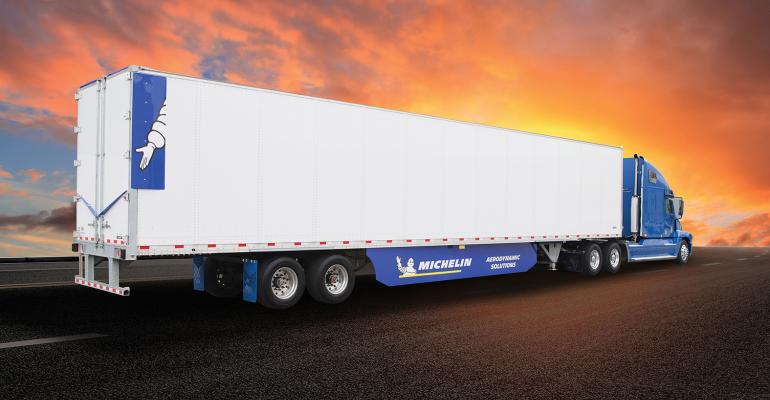Adam Murphy, vice president of marketing for business to business segments at Michelin, discusses recent developments the tire maker has made to help fleets retain drivers and simplify maintenance operations.

MONTREAL, QUE. Amid strong growth in the LTL, regional and last-mile delivery segments due to the rapid rise in e-commerce, fleets are constantly trying to fill the qualified-driver void and simplify their maintenance operations.
Adam Murphy, vice president of marketing for business to business segments at Michelin North America, told Fleet Owner those are the two top pain points the tire maker is trying to address for its commercial fleet customers.
“Everybody’s lives are more complicated than they were in the past, so everybody is looking for ways they can simplify their lives and make things just a little bit easier,” Murphy said during Michelin’s 2018 sustainable mobility summit in Montreal. “We see a ton of growth in things like furniture delivery. Even our traditionally longer-haul or regional customers are building very good last-mile delivery businesses in some of those larger household good deliveries that improve the convenience for consumers.”
To address the needs of those growing segments, Michelin launched a couple of digitally enabled services and solutions over the last five-to-seven years. Here’s a look at what the company's most-recent offerings.
Michelin ONCall is an emergency roadside service provider that delivers a reduction in the length of emergency roadside events for fleets. Say a carrier's roadside time was previously 150 minutes when they had an event, Murphy said they can reduce that time to about 120 minutes with OnCall.
“From a driver’s standpoint, the fleet can say to the driver, ‘That’s 30 minutes less that you’re on the side of the road in a less-than-ideal safety situation,’” Murphy noted.
Michelin Tire Care was launched in 2015 and is a digitally enabled tire preventive maintenance offer. Through the Michelin commercial service network, the company regularly inspects all tires within a fleet – checking pressure, visual inspections, and making sure the tread depth is right. And then it makes the necessary repairs. The goal, according to Murphy, is to help carriers and drivers avoid a roadside event and unnecessary downtime all together.
Michelin Energy Guard is an aerodynamic solution kit that boosts overall fuel efficiency. “It is a part of all the work that we’ve been doing in the past years around improving fuel economy, and, principally for us, it’s been about improving rolling resistance within the tire itself,” Murphy explained.
Murphy stressed that these products were developed to address:
A pain point around fuel savings and offsetting it with maintenance costs.
The inconvenience for the driver.
“There are a couple things that we hear consistently with our fleet customers; number one is drivers,” Murphy said. “It may not be intuitive, but we are devoting a ton of time and energy in thinking about how can we help our fleets better attract and retain drivers in their fleets.”
And when it comes to the tires themselves, Michelin just launched a tire called the X One Line Grip D, which was developed for safety and accident avoidance and promises 25% better snow traction than competitors, Murphy noted.
“Obviously there is a very tangible value to the fleet in terms of accident avoidance, but we are really trying to help our fleets use it with their drivers as a lever as well and as another demonstration of the fact that they are investing in everything they can to make the driver’s experience the best it can be,” Murphy said.
Murphy added that the company also launched” its most fuel-efficient” tire option back in October – the XDA Energy +, which was developed to reduce rolling resistance.
“That’s a huge contributor to the sustainability of mobility today, and frankly it becomes an even greater contributor when you get into vehicles being powered by non-diesel technologies,” Murphy noted.
Michelin is also focusing further developments on manufacturing tires for electric trucks. And the big technical challenge there is torque. Murphy explained the company is working closely with OEMs to ensure it takes into account the evolving needs and requirements of tires from the evolution of powertrain technologies.
“Even with a significantly greater amount of torque being applied to their applications, this is a very significant technical challenge,” he added.
About the Author(s)
You May Also Like


